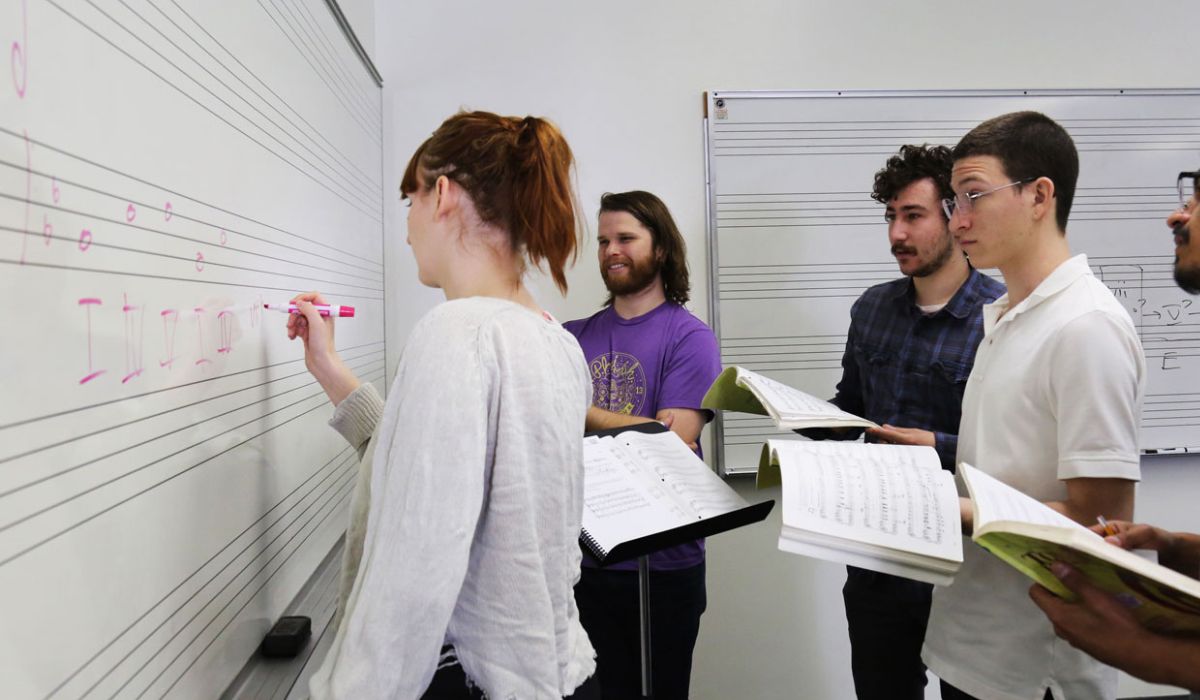Home>Production & Technology>Music Theory>How Hard Is AP Music Theory


Music Theory
How Hard Is AP Music Theory
Published: January 31, 2024
Discover how challenging AP Music Theory can be as you explore the intricacies of music theory. Enhance your understanding of key concepts, notation, and harmony.
(Many of the links in this article redirect to a specific reviewed product. Your purchase of these products through affiliate links helps to generate commission for AudioLover.com, at no extra cost. Learn more)
Table of Contents
Introduction
AP Music Theory is an advanced course offered by the College Board as part of their Advanced Placement (AP) program. It is designed to provide high school students with a comprehensive understanding of music theory concepts and skills. The AP Music Theory exam allows students to demonstrate their knowledge and proficiency in music theory, which can potentially earn them college credit and advanced placement in music-related courses.
This article aims to explore the difficulty level of AP Music Theory and provide insights into the curriculum, concepts covered, and strategies for success in the exam. By gaining a deeper understanding of what AP Music Theory entails, students can make informed decisions about whether to pursue this course and be better prepared for the challenges it presents.
Music theory is the study of the elements and structure of music, including notation, rhythm, harmony, melody, and form. It delves into the principles and techniques that underpin the creation and analysis of music across various genres and styles. AP Music Theory takes students on a journey through the intricacies of music theory, from basic concepts to more advanced analytical skills.
Whether you are an aspiring musician, composer, music educator, or simply have a passion for music, AP Music Theory offers a unique opportunity to deepen your understanding and appreciation of the art form. So, let’s dive into the world of AP Music Theory and explore the challenges and rewards that await!
What is AP Music Theory?
AP Music Theory is an advanced-level course offered by the College Board that provides students with a comprehensive understanding of music theory. It covers a wide range of topics, including notation, scales, harmony, analysis, and composition. The course is designed to develop students’ musical skills and knowledge to a level equivalent to a first-year college music theory course.
As an AP course, AP Music Theory follows a curriculum developed by the College Board, which sets the standards and expectations for the course content. The curriculum includes the study of basic musical concepts, such as rhythm, melody, and form, as well as more complex elements like harmonic progression, counterpoint, and tonal analysis.
The course is typically taken by high school students who have a strong interest in music and wish to pursue further education or careers in music-related fields. It is also beneficial for students who want to enhance their overall musical understanding and abilities, even if they do not intend to pursue music professionally.
In AP Music Theory, students learn how to read and write musical notation, analyze and identify musical patterns and structures, and develop critical listening skills. The curriculum combines theoretical knowledge with practical application, allowing students to apply their learning through composition and analysis exercises.
Throughout the course, students are exposed to a variety of musical styles and genres, including classical, jazz, and contemporary music. They also engage in active listening and develop aural skills, such as sight-singing and melodic dictation, to strengthen their ability to understand and interpret music.
The ultimate goal of AP Music Theory is to provide students with the tools and knowledge to analyze, appreciate, and communicate about music effectively. It equips students with a strong foundation in music theory, which can be invaluable for further studies in music, whether at the collegiate level or in a professional setting.
Next, let’s explore the difficulty level of AP Music Theory and what makes it a challenging yet rewarding course for students.
The Difficulty Level of AP Music Theory
AP Music Theory is widely regarded as one of the most challenging AP courses offered by the College Board. It requires a strong foundation in music fundamentals and a willingness to dive into complex theoretical concepts. The difficulty level of AP Music Theory can be attributed to several factors:
- Comprehensive Curriculum: The course covers a wide range of topics, including notation, harmony, analysis, composition, and aural skills. Students are expected to have a solid understanding of music theory and be able to apply their knowledge to various musical contexts.
- Complex Concepts: AP Music Theory delves into intricate and advanced concepts such as chord progressions, voice leading, modulation, and advanced rhythmic patterns. These concepts require critical thinking and analytical skills to grasp and apply effectively.
- Technical Skills: The course also emphasizes technical skills such as sight-singing, melodic dictation, and harmonic analysis. Developing these skills takes practice, precision, and a keen ear for musical nuances.
- Ear Training: A significant component of AP Music Theory involves developing aural skills, including the ability to identify intervals, chords, and rhythmic patterns by ear. This can be challenging for some students, as it requires both a theoretical understanding and the ability to apply that knowledge in a practical listening context.
- Time Commitment: AP Music Theory often requires a substantial time commitment outside of the classroom. Students are expected to practice their instrument or voice, complete composition and analysis assignments, and review material regularly to ensure a deep understanding of the concepts.
Despite the challenges, AP Music Theory offers numerous benefits. It provides students with a solid foundation in music theory, improves critical thinking and analytical skills, strengthens musicianship abilities, and enhances overall musical understanding. Additionally, success in AP Music Theory can lead to college credit or advanced placement in music-related courses, saving students time and money in their higher education journey.
With the right mindset, dedication, and support from teachers and peers, students can overcome the difficulties of AP Music Theory and experience the satisfaction and growth that come from mastering this subject. In the next sections, let’s delve into the specific curriculum, musical concepts, and exam format of AP Music Theory to gain a better understanding of what the course entails.
Curriculum Overview
The curriculum of AP Music Theory is designed to provide students with a comprehensive understanding of music theory concepts and skills. It covers various aspects of music theory, from basic principles to more advanced analytical techniques. Here is an overview of the main areas covered in the AP Music Theory curriculum:
- Notation: Students learn to read, write, and interpret musical notation, including pitch, rhythm, dynamics, and articulation. They become familiar with the symbols used in music notation and understand how to apply them in a musical context.
- Scales and Key Signatures: The study of scales and key signatures is essential for understanding tonality and harmonic relationships. Students learn to identify and construct major, minor, and modal scales, as well as understand the concept of key signatures and their role in tonal music.
- Intervals: Intervals form the building blocks of melody and harmony. Students learn to identify and label intervals, both melodic and harmonic, and understand their characteristic qualities and relationship to musical context.
- Chords and Harmony: AP Music Theory delves into chord construction, chord progressions, and functional harmony. Students learn to analyze and identify chords, Roman numeral analysis, and harmonic relationships within a piece of music.
- Rhythm and Meter: The study of rhythm and meter involves understanding the organization of time in music, including beats, note values, time signatures, and rhythmic patterns. Students learn to read and interpret complex rhythmic notation and analyze rhythmic structures in music.
- Musical Form: Musical form refers to how a piece of music is structured and organized. Students learn about different forms such as binary, ternary, rondo, and sonata form, and develop the ability to analyze and identify these forms in various musical compositions.
- Composition and Analysis: AP Music Theory includes opportunities for students to engage in composition and analysis exercises. They learn to compose melodies and harmonic progressions using the principles of music theory, as well as analyze and interpret the musical elements and structure of existing compositions.
- Aural Skills: Aural skills are an integral part of the AP Music Theory curriculum. Students develop the ability to sight-sing, recognize melodic and harmonic patterns by ear, and perform melodic dictation and rhythmic dictation exercises.
The curriculum is designed to provide a comprehensive and well-rounded education in music theory, equipping students with the knowledge and skills needed to engage with music at a deeper level. In the following sections, we will explore the specific musical concepts covered in AP Music Theory and the skills required for success in the course.
Musical Concepts Covered
AP Music Theory covers a wide range of musical concepts that are essential for understanding and analyzing music. These concepts provide students with a solid foundation in music theory and enable them to engage with music on a deeper level. Here are some of the main musical concepts covered in AP Music Theory:
- Rhythm: The study of rhythm involves understanding the relationship between notes and rests, the different time values of notes, and how they are organized within a piece of music. Students learn to read, write, and interpret rhythmic notation accurately.
- Melody: Melody is the linear organization of pitches. AP Music Theory explores the techniques used in creating melodies, including scale patterns, phrase structure, and melodic contour. Students learn to analyze melodies and identify their structural elements.
- Harmony: Harmony refers to the vertical organization of pitches and the interaction between chords. Students study chord progressions, harmonic function, and the principles of voice leading. They learn to analyze and identify harmonic relationships within a piece of music.
- Chord Progressions: Chord progressions are the series of chords used in a piece of music. Students learn about common chord progressions and how they create tension and resolution. They analyze and identify chord progressions and their harmonic function.
- Form: Form refers to the structure and organization of a musical composition. Students study various musical forms, such as binary, ternary, rondo, and sonata form. They learn to identify and analyze the different sections and their relationships within a piece.
- Counterpoint: Counterpoint is the art of combining multiple melodic lines harmonically and melodically. Students study the rules and techniques of counterpoint, including species counterpoint and voice leading. They learn to create contrapuntal melodies and analyze contrapuntal compositions.
- Texture: Texture refers to the overall quality and density of musical sounds. Students explore different types of textures, such as monophonic, homophonic, and polyphonic textures. They learn to analyze and identify the texture of a musical composition.
- Instrumentation and Orchestration: Students gain an understanding of the different musical instruments and their capabilities. They learn to recognize and analyze the use of instruments in compositions and understand the concepts of orchestration and timbre.
These are just a few examples of the many musical concepts covered in AP Music Theory. By studying these concepts and developing a strong theoretical foundation, students can enhance their abilities to analyze, appreciate, and create music in various genres and styles. With a deeper understanding of these musical concepts, students are better equipped to excel in the AP Music Theory exam and pursue further studies in music-related fields.
Sight Singing and Aural Skills
One essential component of AP Music Theory is the development of sight singing and aural skills. Sight singing involves the ability to read and sing a piece of music accurately and fluently, without prior knowledge or rehearsal. Aural skills, on the other hand, refer to the ability to identify and understand musical elements solely by listening.
In AP Music Theory, students practice and refine their sight singing abilities through exercises that involve reading and singing melodies, rhythms, and vocal exercises. They learn to recognize and reproduce the correct pitches, rhythms, and dynamics indicated on the music sheet. Sight singing not only helps students become better musicians but also improves their overall musicianship and ability to interpret and perform music accurately.
Aural skills play a crucial role in AP Music Theory as well. Students develop the ability to recognize and identify melodies, harmonies, intervals, and chord progressions by ear. This involves listening to musical excerpts and accurately identifying the pitch, rhythm, and tonal elements within the piece. Aural skills enable students to analyze and understand the structure, form, and expressive qualities of music without relying solely on notation.
Throughout the course, students engage in exercises that enhance their aural skills, such as melodic and rhythmic dictations. In melodic dictation, students listen to a melodic line and notate it accurately on paper, including the pitches, intervals, and rhythms. Rhythmic dictation focuses on reproducing and notating complex rhythmic patterns accurately.
Developing strong sight singing and aural skills takes time, practice, and consistent effort. It requires a keen ear and a solid understanding of musical elements and relationships. However, these skills are invaluable for musicians, as they enhance their ability to listen critically, perform accurately, and communicate effectively with other musicians.
By honing their sight singing and aural skills, students not only prepare themselves for success in the AP Music Theory exam but also equip themselves with lifelong tools that can be applied to any musical endeavor. Effective sight singing and aural skills allow musicians to connect with and interpret music on a deeper level, opening up new possibilities for musical expression and enjoyment.
Music Theory Skills and Analysis
In AP Music Theory, students develop a range of music theory skills and learn to analyze and understand the structure and elements of musical compositions. These skills are crucial for interpreting and appreciating music at a deeper level. Here are some key music theory skills and analysis techniques covered in the course:
- Harmonic Analysis: Students learn to analyze and identify the chords and harmonic progressions used in a piece of music. This involves recognizing common chord patterns, understanding chord function, and labeling chords using Roman numeral analysis.
- Formal Analysis: Formal analysis focuses on understanding the structure and organization of a musical composition. Students learn to identify and analyze different sections, such as the exposition, development, and recapitulation in sonata form, or the verse-chorus structure in popular music.
- Counterpoint Analysis: Counterpoint analysis involves studying the interaction of multiple melodic lines. Students learn to identify and analyze contrapuntal techniques, such as canon, fugue, and imitation, and understand the rules of voice leading and independent melodic lines.
- Modal Analysis: Modal analysis explores music written in modes other than major and minor. Students learn to identify and analyze music in modes such as Dorian, Phrygian, Mixolydian, and more. They learn to recognize the characteristic melodic and harmonic elements of each mode.
- Score Analysis: Score analysis involves examining a musical composition through its written notation. Students learn to analyze the various expressive markings, dynamics, articulations, and phrasing indicated in the score, as well as understand the notation of complex rhythms and extended techniques.
- Transposition and Arrangement: Students develop the ability to transpose music from one key to another and rearrange compositions for different instruments or ensembles. This skill involves understanding tonal relationships, key signatures, and instrumental capabilities.
- Composition Techniques: AP Music Theory also explores composition techniques, including melody writing, harmonic progression, and voice leading. Students learn to apply these techniques while composing their own original music.
Developing these music theory skills and analysis techniques enables students to gain a deeper understanding of the inner workings of a musical piece. It allows them to appreciate the composer’s choices and intentions, interpret the expressive elements, and communicate their own musical ideas effectively.
Music theory skills and analysis are not only valuable for musicians, composers, and music educators but also for anyone with a passion for music. These skills enhance overall musicianship, critical listening, and the ability to engage with music in a more meaningful and informed manner.
In the next section, let’s explore the format and scoring of the AP Music Theory exam, as well as some strategies for success in preparing for the exam.
Exam Format and Scoring
The AP Music Theory exam consists of two main sections: multiple-choice and free-response. The exam is designed to assess students’ knowledge and understanding of music theory concepts, as well as their ability to apply that knowledge in practical scenarios.
Multiple-Choice Section:
The multiple-choice section of the AP Music Theory exam consists of a series of questions that assess students’ understanding of musical elements, notation, listening skills, harmony, and analysis. Students are presented with a musical excerpt, a score, or a question prompt and must select the most appropriate answer from the given options.
Examples of multiple-choice questions may include identifying chords, intervals, key signatures, cadences, or analyzing harmonic progressions and recognizing formal structures.
Free-Response Section:
The free-response section of the AP Music Theory exam consists of both written and practical components. In this section, students are required to demonstrate their ability to apply music theory concepts and skills in real-world scenarios.
The written portion of the free-response section typically includes tasks such as analysis, composition, and harmonic dictation. Students may be asked to analyze a musical composition, write a melodic or harmonic exercise, or notate a rhythmic pattern based on a given musical example.
The practical portion of the free-response section includes sight-singing and melodic dictation exercises. Students are required to listen to a musical excerpt or dictate a melodic line and accurately notate it using standard music notation.
Scoring:
The AP Music Theory exam is scored on a scale of 1-5, with 5 being the highest score. The multiple-choice section accounts for 50% of the overall score, while the free-response section accounts for the remaining 50%.
Each section is graded by experienced AP Music Theory teachers and college professors who follow specific scoring guidelines provided by the College Board. The scoring criteria take into account the accuracy and completeness of responses, as well as the application of music theory concepts and skills.
It is important for students to familiarize themselves with the scoring rubrics and practice answering questions and tasks in a manner that meets the criteria for each section. This includes demonstrating a solid understanding of music theory principles, providing clear and concise explanations, and applying correct notation and musical terminology.
Preparing for the AP Music Theory exam requires a combination of theoretical knowledge, practical skills, and effective exam strategies. In the next section, we will discuss some strategies for success in AP Music Theory and tips for preparing for the exam.
Strategies for Success in AP Music Theory
Preparing for the AP Music Theory exam requires dedication, practice, and a strategic approach. Here are some strategies to help you succeed in your AP Music Theory journey:
- Develop a Strong Foundation: Building a strong foundation in music theory basics is essential. Make sure you have a solid understanding of notation, scales, intervals, chords, and key signatures before diving into more advanced concepts.
- Practice Sight Singing and Aural Skills: Regularly practice sight singing and aural skills exercises. This will strengthen your ability to read and reproduce music accurately, as well as improve your ear training and recognition of musical elements.
- Engage with Music: Actively engage with music by listening to a wide variety of genres and styles. Pay attention to the different elements and structures within the music, and try to identify the theoretical concepts at play.
- Analyze Musical Compositions: Analyze and study musical compositions from different periods and styles. Focus on identifying key elements such as harmonic progressions, melodic structures, formal organization, and texture. Practice labeling chords, analyzing modulations, and recognizing common musical forms.
- Do Regular Practice Exercises: Consistently practice exercises that reinforce your understanding of music theory concepts. Complete written assignments, compose melodies or harmonic progressions, and practice sight singing and dictation exercises to enhance your skills.
- Seek Feedback: Engage with your music teacher or instructor and seek regular feedback on your progress. They can guide you in areas that need improvement and provide valuable insights to help you succeed in the exam.
- Use Resources and Study Materials: Utilize study guides, textbooks, online resources, and AP Music Theory review materials. These resources can provide additional explanations, practice questions, and sample essays to help you understand difficult concepts and familiarize yourself with the exam format.
- Time Management: Practice effective time management skills during your exam preparation. Create a study schedule that allocates time for reviewing concepts, practicing skills, and completing practice exams. This will ensure that you cover all the necessary material and feel confident leading up to the exam.
- Practice Past Exams: Familiarize yourself with the format and types of questions asked on the AP Music Theory exam by practicing past exams. This will help you become more comfortable with the structure, timing, and expectations of the exam.
- Stay Calm and Confident: On the day of the exam, stay calm and composed. Trust in your preparation and believe in your abilities. Approach each question with focus and confidence, and if you encounter a challenging question, do not get discouraged. Take a deep breath, make an educated guess, and move on.
By implementing these strategies, you can enhance your understanding of music theory, develop the necessary skills, and be well-prepared for the AP Music Theory exam. Remember to maintain a consistent and dedicated approach to your studies, seeking help when needed, and utilizing available resources. With perseverance and a positive mindset, you can excel in AP Music Theory and reap the rewards of your hard work.
As you embark on your AP Music Theory journey, embrace the joy of learning and exploring the rich world of music theory. Enjoy the process of unraveling the intricacies of musical compositions and deepening your understanding of this universal language.
Good luck on your AP Music Theory exam!
Conclusion
AP Music Theory offers students the opportunity to delve into the fascinating world of music theory and develop a deeper understanding of the elements and structure of music. Throughout this article, we have explored the difficulty level of AP Music Theory, the comprehensive curriculum, the range of musical concepts covered, and the importance of sight singing and aural skills.
AP Music Theory challenges students to explore complex theoretical concepts, develop practical skills, and refine their analytical abilities. It requires a strong foundation in music fundamentals and a willingness to engage with music on a deeper level.
By successfully completing the AP Music Theory course and exam, students can earn college credit, showcase their musical abilities, and open doors to further study and careers in music-related fields. The skills and knowledge gained from this course extend beyond the exam and can be applied to all aspects of music-making and appreciation.
To excel in AP Music Theory, students should focus on building a strong foundation in music theory, practicing sight singing and aural skills, analyzing musical compositions, and utilizing effective study strategies and resources. Consistency, dedication, and a passion for music are key to success in this challenging yet rewarding course.
As you embark on your AP Music Theory journey, embrace the joy of learning and exploring the intricacies of music. Develop your skills, engage with various musical styles, seek guidance from your teachers, and immerse yourself in the rich world of music theory.
Remember, AP Music Theory is not just a pathway to college credit; it is an opportunity to deepen your understanding and appreciation of music and enhance your musicianship. Embrace the journey, practice diligently, and let your love for music guide you to success in AP Music Theory and beyond.











